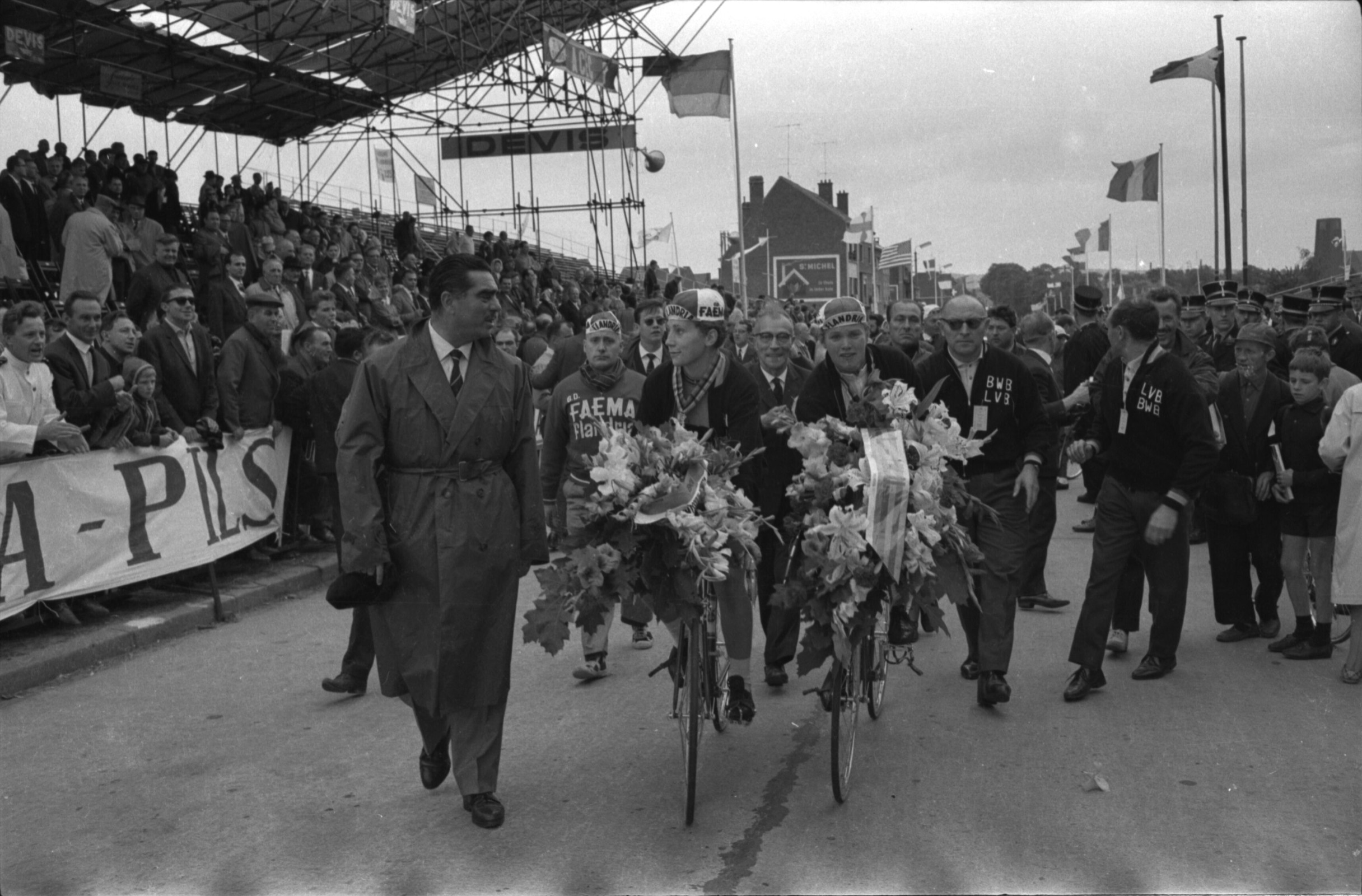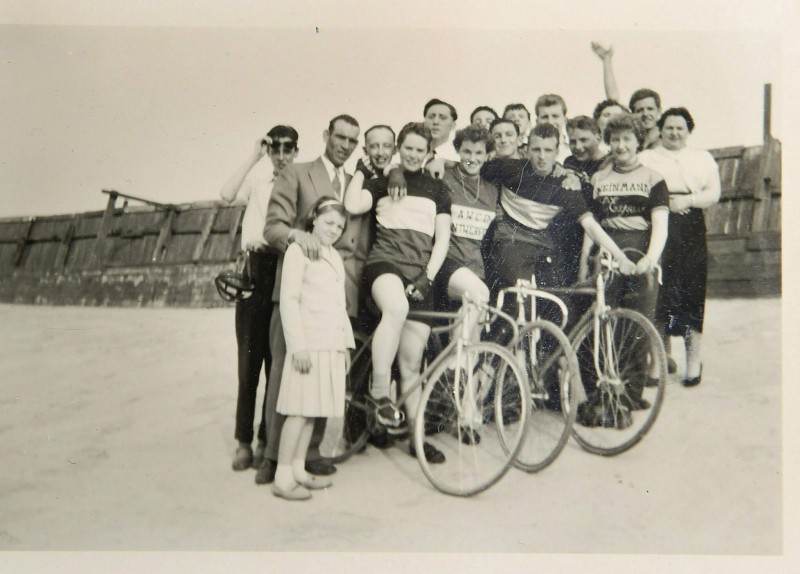Six decades later, the four-kilometre triangular circuit on the territory of Neupré counts a local bank, a chip shop and the police station as reference points. With the hum of traffic behind us and the wind blowing from the fields, it is easy to imagine the struggle of a group of cyclists for the rainbow jersey. A year after the very first Women's World Championship (1958), this battle was decided on Belgian soil. The fact that there was a World Championship for women in 1959 seems to have faded from collective memory.
On 28 November 1958, tensions run high in an auditorium in Zurich, where the 109th UCI Congress takes place that day. The President of the KNWU, the Dutch Cycling Federation, sounds the alarm and announces that he will not be able to organise the Women's Road Race allocated to him. The World Championship for amateurs is also in jeopardy. The KNWU says it is struggling with various problems and says that the desired programme for the World Championships is too extensive for the organizing city, Zandvoort, and that there are not enough accommodations. The members of the Belgian Cycling Federation present at the event have little faith in this explanation. If the Women's road race is cancelled, they say, it will be because the race is not interesting enough financially or due to a lack in interest by the general public. The Belgians will then apply to take over the organisation of the Women's World Championship "to help the UCI get out of the impasse". The top of the Belgian Cycling Federation agrees, on one condition: the event is to be organised with a minimum of costs. Only on 1 July 1959, one month (!) before the actual World Championships, the board of the Velodrome of Rocourt gets the green light to organise the Women's Track Cycling World Championships while the Vélo Club Rotheusien gets to organise the Women's Road Cycling World Championships.
Minimal preparation time, uncertain income, little infrastructure: the prospects are not very promising. But that doesn't stop Camille Deloge, who didn't break much ground as a cyclist but turned out to be a born organiser. "My father was not one to shy away from such challenges, it was in his blood", daughter Josiane Deloge remembers. "He seized every opportunity to attract cyclists to his region, he was prepared to do whatever was necessary. He knew how to knock on the right doors to bring his projects to a successful conclusion. In the run-up to the World Championship in his municipality, he had no trouble convincing several families in the village to give the riders a place to stay. The participants were also welcomed into Camille's home: "We cooked a nice meal, sat around the table together in the evening... It was fun," continues the organiser's daughter. The organisation of the World Championships in Rotheux comes at a pivotal moment in the history of women's cycling.
Hosting the Women's World Championship in its own country is a stroke of luck for the BWB. It allows the federation to present itself as a progressive organization, which is committed to women's cycling. Although Belgium is a real cycling powerhouse, it lags seriously behind when it comes to women's cycling. The first national championship for women cyclists, recognized by the Belgian Cycling federation, only came in 1959, eight years after France, twelve years after Great Britain and 32 years after the Soviet Union.
The organisation of the World Cup in Rotheux comes at a pivotal moment in the history of women's cycling.
Although there was a first breakthrough in 1957, when some track events were allowed, we had to wait until the first women's world championship, on 30 August 1958, for the Belgian Cycling Federation to consider the possibility of female licences. However, that same year a handful of Belgian women were at the start of the historic first ever World Championship in Reims. But that was thanks to the UCI, which gave some Belgian riders starting rights despite the lack of an official Belgian licence. Instead of the traditional blue jersey, the ladies - Yvonne Reynders, Liliane Cleiren, Nadia Germonpré and Victoire Van Nuffel - wear a white jersey. Virgin white, for this new category of riders with underestimated potential. But perhaps also the white of indifference.
In the Belgian press there is hardly any mention of this event. A few months after the 1958 World Championships, the Belgian Cycling Federation declares, after months of heated debate, that it will recognise women's races and permits from 1959. The decision was not so much motivated by the desire for equality between riders and women as it was to put an end to the illegal races that had been growing for several years and the activities of their organisers, who were profiting from them and all this without any official framework. "These competitions give rise to shameless exploitation. The federation urgently needs to put an end to the actions of those who have been exercising a damaging monopoly for months", we read in the archives of the Belgian Cycling Federation. On 28 June 1959, under a scorching sun, the first official national championship for women in Belgium takes place in the park of Antwerp. Victoire Van Nuffel becomes the first Belgian champion. Two months later the international elite is invited to the World Championships on the other side of the language barrier.
On the afternoon of August 2, the province of Liège is hit by torrential rain. It is abnormally cold for the time of year, but the roadside is crowded. Supporters of the first hour, intrigued spectators and the curious stand side by side to watch the race. "How proud we were!", recalls Mr Flohimont, then 16 years old. "Despite the rain, all the friends of our veloclub were there. For us, it was fantastic that we could organise this in our little village. A year earlier we had already travelled by coach to the Champagne region to witness the very first women's World Championship from the front row."
Thirty participants will be at the start. Belgium, the United Kingdom and East Germany sent six participants, France five, the U.S.S.R. four, the Netherlands two and finally Luxembourg one, title holder Elsy Jacobs. The latter, the feared Russians and the tactically strong British are favourites for victory. Yet one Belgian is also put forward: "Yvonne Reynders can be a dangerous outsider," predicts Le Soir. Although the results so far have not been convincing, the 22-year-old from Antwerp has some serious trump cards: a solid acceleration, doggedness and enormous strength. Since she was 16, she has been carrying kilos of coal through the city on her cargo bike. To save time, she works as efficiently as possible: she piles about twenty ten-kilo bags on her cargo bike and delivers them to people' s homes, sometimes as far as the seventh floor. The urge to win, so it is said, comes from her troubled relationship with her father who, besides being a coal merchant, is also known as an alcoholic and violent man. In spite of these traits, Reynders supports his daughter in her dreams of cycling and her struggle for recognition.
The race plays out on the soggy track, without much happening. When the final arrives, the competition is still locked in. But the seventeenth (and penultimate) lap is decisive. One of the English riders slips on the asphalt and in her fall takes half of the riders with her, who are scattered over a distance of 500 metres. "I should have been world champion that year", Marie-Thérèse Naessens, riding her first world championship, looks back in a sad voice. The 83-year-old former Flemish cyclist, bronze medallist at the 1962 World Championships and four-time national speed champion, has bitter memories of this championship. "I was in good shape and in a good position in the race, but I got involved in a massive crash on the penultimate lap. Only the riders at the back of the pack were able to avoid the crash. Once they got back on their feet, it was too late to catch them.
A limited group rushes off, with the Russians in the lead. At 200 metres there is one last hairpin turn before the finish line. The group swings to the outside of the slightly rising curve, except for one person. In a few moves, Yvonne Reynders accelerates via the right side and passes her competitors one by one without looking back. The bird has taken flight. In Rotheux in Wallonia, a Belgian rider is dominant.
At her home in Zoersel, located in the Antwerp, Yvonne Reynders treasures the fond memories she has of Rotheux-Rimière. Of the waving hands, cries of joy, flower bouquets. Of this strange, almost unreal evening. "People were camping in front of our door. Neighbours, supporters were waiting for me. I went to sleep almost immediately. Only when I lay in bed and wondered what they were doing there did I realise what I had done. I went back downstairs and saw the world champion's jersey that I had given to my supporters earlier. I had already given my flower owl to the people in Rotheux where I was staying. And then it really dawned on me that I was world champion."
Today, the octogenarian has long put the bike away. She has exchanged the nervousness of cycling races for the tranquillity of fishing and flower gardens. She smiles occasionally when she sees Jolien D'Hoore, Sanne Cant or Lotte Kopecky, standard-bearers of the current generation of Belgian cyclists, at work on TV. But nobody comes even close to the palmares of this pioneer. Seven times world champion (four titles on the road, three on the track), eleven national gold medals. She has not made any money or fame out of it. While Belgium seems to have forgotten that very first women's World Championship in her own country, the former cyclist remembers it only too well. That year, 1959, the only Belgian victory at the World Championships was that of a woman.
With the first official, UCI-recognised world championship for women in 1958, (international) women's cycling faced a turning point. One year...



